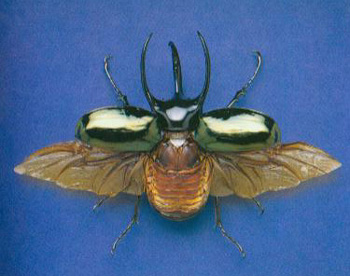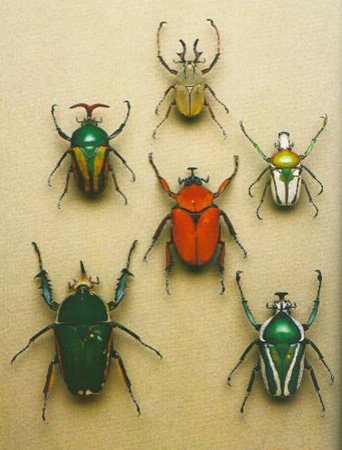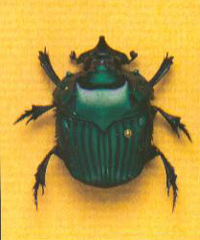An Inordinate Fondness for Beetles
Arthur Evans and Charles Bellamy
Photographs by Lisa Charles Watson
“This beautiful book...recounts not only the natural history of beetles
but the human history of them as well. The best thing about this book,
however, are the photographs. Most of the specimens are pictured close-up,
pinned on carefully chosen colored paper, more beautiful than nearly anything
made by man, and proof not only of God’s fondness for these creatures
but also of His exquisite good taste.”
![]() —Washington Post
—Washington Post

An Atlas beetle (Chalcosoma Caucasus)
While at an international gathering of scientists, J.B.S. Haldane, famous
for his genetic theories and infamous for his outspoken atheism, was approached
by a cleric from the Church of England. This priest, a scientists in his
own right, asked Haldane to suspend his disbelief for a moment and speculate
on what his lifelong study of nature might reveal about a creator. "He
has," Haldane responded, "an inordinate fondness for beetles."
Just how many kinds of beetles there are nobody knows. Estimates range from 350,000 to over 8 million species of beetles. They represent, in themselves, an amazing 25% of all known animals including other insects, mammals, reptiles, birds, mollusks, coral, worms, sea anemones on the face of the Earth today. If success is measured by numbers, they are the most successful animals to have ever lived.
The sheer number of beetles is echoed in their ecological diversity. Their habitats stretch from the arctic to the equator, from the alpine to the desert, from the subterranean to the arboreal, and from the terrestrial to the marine. Their sizes range from microscopic to that of a box turtle a range greater than that between the smallest mammal, a shrew, and the largest, a blue whale. Their variety of colors and shape is unsurpassed in the animal kingdom.
The question arises, and this is the central theme of An Inordinate Fondness for Beetles, what is the source of this unparalleled biodiveristy? Why are there so many different kinds of beetles in such overwhelming numbers, living in so many places?
Rights available:
World except Japan, Korea, and North America

Tropical Golianthine Scarab beetles.
Specifications:
208 pages
96 color photographs
27 black and white illustrations
3 appendices
bibliography
index
Dimensions: 10.9 x 9.1 x 0.6 inches
Shipping Weight: 2.1 pounds
Arthur V. Evans, D.Sc., is the director of the Insect Zoo at the
Natural History Museum of Los Angeles County. Author of numerous papers
on the systematics and biology of scarab beetles, he now focuses his energies
on living insect exhibits as a means of introducing the general public
to the fascinating world of the most successful animals on Earth.
Charles L. Bellamy, D.Sc., is a senior curator in the Department of Coleop-tera at the Transvaal Museum in Pretoria, South Africa. Considered one of the world’s leading authorities on jewel beetles, he has traveled extensively throughout the world in search of clues to their evolutionary development.
Lisa Charles Watson is an award-winning photographer who lives in New York City
Reviews
“This adoring tribute to beetles seeks to answer...what
makes these animals so persistent in nature and prevalent in history”
![]() —Science
News
—Science
News
“The authors state their primary target
is a general audience, and they hope to instill in it a greater appreciation
for beetles and the scientists who study them. The target was well hit....This
book is for the layperson, the amateur, or the professional entomologist....Their
treatment, which provides the reader with the potential for a deep under-standing
and appreciation, is nothing short of admirable. I highly recommend this
reasonably priced book, especially for anyone with an 'inordinate fondness
for beetles'.”
![]() —American
Entomologist
—American
Entomologist
“Beetles rarely elicit from us feelings
of sympathy we easily afford cute and cuddly vertebrates’ the authors
lament. So they have advanced an agenda of ‘beetlephilia,’ a
scientific appreciation of the importance of beetles to the global eco-system
and a personal feeling that, by gosh, beetles sure are fascinating. The
playful artistic photographs give the books facts and figures a rare visual
grounding...a swift, unforgettable lesson in the almost magical efficiency
of beetle anatomy.”
![]() —Scientific
American
—Scientific
American
“An authoritative reference volume resplendently
illustrated with line drawings and color photographs.”
![]() —Nature
—Nature

Central American Dung beetle
(Oxysternon conspicillantum).
“The jewel-like beauty of the world’s largest group of insects
is breathtakingly captured in this handsome volume. Divided into six sections,
this outstanding visual reference contains three appendices, selected
references, and an index.”
![]() —Library Journal
—Library Journal
“A bug-lovers bible.”
![]() —College & Research Libraries News
—College & Research Libraries News
“This is the age of beetles, note the authors of this delightfully
detailed and richly illustrated book”
![]() —San Diego Union Tribune
—San Diego Union Tribune
“[In] this magnificent volume, written by two leading
coleopterists, . . .the pages are large (9 x 11 inches), and the first
thing one notices are the beautiful color plates. These photographs .
. . are of outstanding quality. It would seem impossible to improve upon
the color, clarity, and sharpness of focus of these plates.”
![]() —Choice
—Choice
“These two scientists not only display some of the
most spectacular specimens, but also give fascinating accounts of the
strange life cycles and morphologies of these often ignored arthropods.”
![]() —E Magazine
—E Magazine
A beautiful and thorough look at the entire realm of beetles
including the locales in which they are found, history, anatomy and physiology,
and their relationships with humans. The incredible full-color photographs
bring readers up close…[to] the seemingly infinite variations within
the species ….”
![]() —School Library Journal
—School Library Journal
“Here is the non-specialist's chance to be inspired. Evans' and Bellamy's
journey through beetle ecology is everywhere enhanced by Watson's bright
pictures of some of nature's most exquisite creatures. Seek fondness,
yes; find wonder and awe.”
![]() — BBC Wildlife Magazine
— BBC Wildlife Magazine
“In the title, apocryphally ascribed to the great scientist
J. B. S. Haldane, God is allegedly the one fond of beetles, because He
created so many varieties of them. Ordinary mortals like them, too, and
Evans and Bellamy have written this colorful bestiary for them. The variety
of the little buggers (and some are not so little) is astounding and reflects
their evolutionary success in every land environment over the past 240
million years. Visually they can be stunningly jewel-like, a facet of
attraction beautifully illustrated in about 100 color plates. The text
tightens the pictures to an understanding of beetles' anatomy, possible
evolutionary history, behavior, and adaptation strategies. The graphic
design helps induce this strong picture-word connection: one never need
search around for a photo's pertinent text; biological terms are in boldface;
headings are in red…. Numerous line drawings further strengthen the
impression this resource makes; and whether students or collectors, its
users will be well launched into coleopterology. “
![]() —Booklist
—Booklist
Click here to return to book.